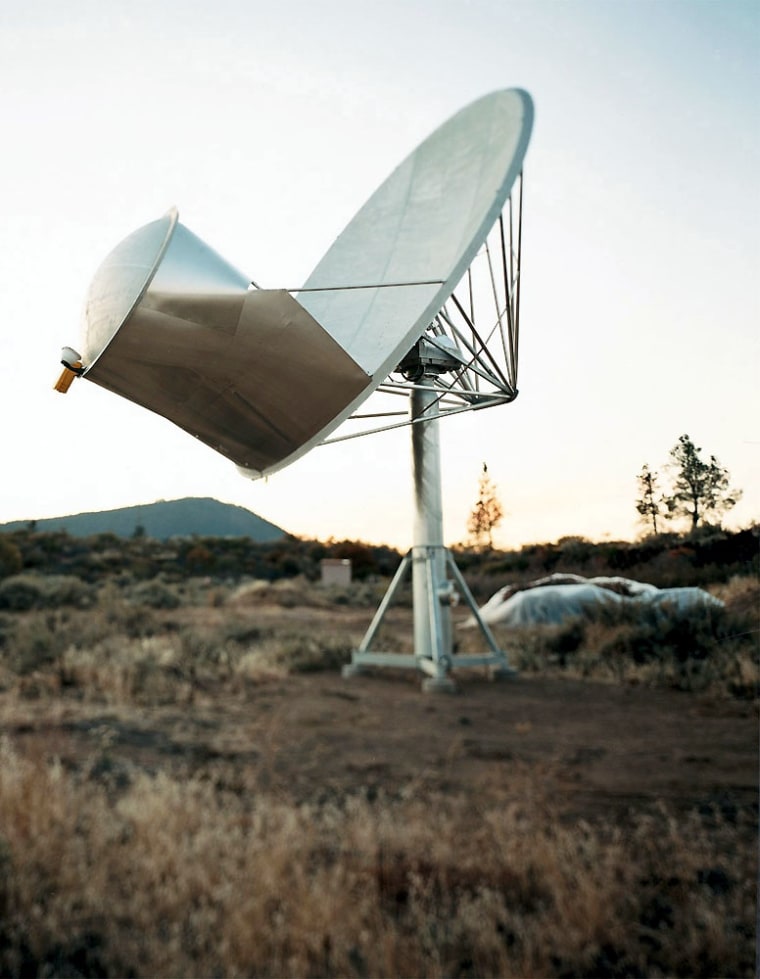Billionaire Paul Allen is giving $13.5 million to research that includes looking for intelligent life in outer space, bringing his total donations to the project to $25 million.
Allen, a co-founder of Microsoft Corp. and the fifth-richest person in the world, announced his latest gift in a groundbreaking ceremony for the Allen Telescope Array on Thursday in Palo Alto, Calif. (MSNBC is a Microsoft-NBC joint venture.)
Besides the search for extraterrestrial intelligence, or SETI, the radio astronomy project is directed at examining quasars, cosmic explosions and the birth of stars for clues to the origin of the universe, its composition and where it may be headed.
"We're pushing the technology of radio astronomy with this," Allen told the Seattle Post-Intelligencer by telephone. "This will be fascinating."
In radio astronomy, scientists examine radio frequencies in the electromagnetic spectrum rather than the visual light portion.
The new telescope, actually a network of 350 small radio-frequency dishes linked by computer, is being built on about 2.5 acres (1 hectare) of lava beds north of Lassen Peak near the high-desert hamlet of Hat Creek, about 215 miles (345 kilometers) north-northeast of San Francisco.
One potential for the network is to boost the chance of detecting radio frequencies that could indicate advanced civilizations in outer space.
"If they get that signal, it would be incredible," Allen said.
Science fiction and fact
Allen told The Seattle Times the project reflects the interests that recently led him to announce plans for a new science fiction wing at the Experience Music Project, a museum he largely financed in the shadow of the Space Needle in Seattle.
"Obviously, if you could discover a signal, that would be one of the breakthroughs of all time," he said. "The subject of a lot of science fiction is actual contact with alien races, and of course all that is very special and fun to me."
Organizers of the radiotelescope project hope to have the first 32 dishes in operation this year and the rest by the end of the decade.
"We've spent the past decade looking at slightly less than a thousand stars," said Jill Tarter, research director of the SETI Institute in Mountain View, Calif., and the model for Jodie Foster's character in the movie "Contact."
"With this, we'll be able to explore from 100,000 to a million stars over the next decade," Tarter said.
The SETI Institute's chief executive, Thomas Pierson, said the group must raise $16 million from other sources to move to the second phase, an expansion to 206 dishes.
Congress quit funding SETI in the early 1990s, but Allen and other private donors, including such high-tech magnates as David Packard, William Hewlett and Gordon Moore, provided money that "resurrected it from the ashes," Tarter said.
Allen's earlier $11.5 million gift went partly for construction and testing of three dishes over the past two years.
Other donors to the Allen Telescope Array include the National Science Foundation, $1.5 million; and former Microsoft technology chief Nathan Myhrvold, $1 million.
Joining SETI as a partner in the project is the Radio Astronomy Laboratory at the University of California at Berkeley. Director Leo Blitz, an expert on the formation of galaxies, said he hoped to gain new information on how tightly packed the universe was when it was just 10 minutes old.
"I think we'll get a lot of important new information about the evolution of the universe from this project," Blitz said.
"SETI wants to know if we're alone," he said. "I want to know how we got here."
